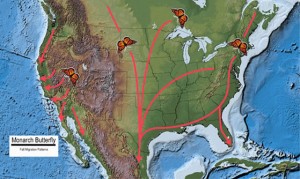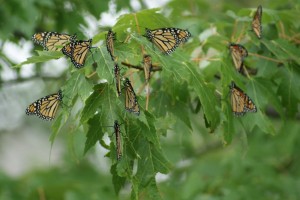Have you ever wondered what the greatest wonder is to scientists? Well if you ask them about the migration of the monarch butterflies it would be at the top of the list. It is certainly a topic most people wouldn’t think of, but everything these little insects do to get to their vacation home is quite remarkable. From fluttering, breeding, finding food and braving extreme weather these black and orange butterflies go through measures to get to the south.
Alright, let’s be honest about the fact that these 27 grams (the weight of 8 pennies!) fly 3,000 miles to get to Mexico or California. Why do they have two different locations? Great question, let me tell you:
Eastern Monarch Butterflies
These little fellers will fly to the Sierra Madre Mountains in Mexico and Michoacán where they will roost two miles above sea level with a temperature of 32 to 59 degrees Fahrenheit in the oyamel fir forests. They will roost in the oyamel firs and cluster in groups of tens of thousands on a single tree! Now even though these insects weigh a pocket change in grams, they can break a branch when in thousands. I would feel pretty intimidated at that point.
Western Monarch Butterflies
Now our friends in the western part of North America (North Dakota, Montana, etc.) will flutter to the Pacific Coast of Santa Cruz and San Diego. These Californian climate conditions are similar to the climate in Mexico. While the eastern butterflies lounge the day away in oyamel firs the westerns hibernate in eucalyptus, Monterey pines and Monterey cypresses.
After reading how they go their separate ways when it comes time to head south, why don’t the monarchs, unlike other butterflies, hibernate in the winter as larvae or pupae? Well, because monarchs don’t survive the harsh northern winters which make them dry out easily.
Heading South
So how do the monarchs exactly get to their destinations? Well scientists have been wondering the same thing for years. These past few years they finally caught a grasp of this amazing trek and how these insects migrate every year even when they have never been their themselves. They use a sun compass and the receptor is on their antenna. This is somewhat relatable to a GPS that we have on our phones. On overcast days, researches idea is that they use earth’s magnetic pull. The butterflies that are heading to Mexico will meet up in a Texas flyway and finish the migration together. Now, after getting the basic layout here comes the real “How do they know that?” moment: the butterflies that fly back in the spring are the great-grandchildren of the monarch that came in to the grove of trees in autumn.

Homeward Bound
Monarch butterflies do eventually have to return back to the north. They breed and lay their eggs, and start journey back up north. The ride back isn’t always smooth and sweet flying, it sometimes can become brutal and a struggle to get home. They are always on a look out for milkweed (only food their young can eat) and the extreme weather like drought and rain storms can eliminate thousands of the butterflies. In the future conservationists predict that the forests the monarchs are homing in, may die off and all the milkweed they eat will soon disappear. Why are all these issue uprising? Well farmers don’t like milkweed, they cause their plants to grow awkwardly. In the mountain of Mexico logging is an issue. Now if you are worried as much as I am about the declining population of the monarchs you can help, too. It doesn’t matter where you live, you can help by planting milkweed in your garden, along the side of the road or right-of-way. Grow trees and safe environments where monarch will feel safe. If you are interested in helping or want to show your idea comment below!

I hope after reading my blog that you learned about the migration of butterflies, and you are interested in learning more. I am glad that I decided to share my research with everyone, because every summer in my backyard the monarchs end up in the big maple trees by my pool. It is quite the site and especially after one year I felt like I was in my own butterfly forest! Before leaving I would like to ask some questions, that you could be involved in below:
What are scientists doing to preserve the monarchs and their habitats?
Are there any other wintering spots for monarchs, if their current places are destroyed?
How many years until the monarch population is are in full bloom, or the opposite extinct?
Video……

I was thinking about the last question you asked at the end of your blog. Being someone who likes butterflies and their study, I started to wonder how close to extinction they actually were, so I did some research. I found that the population of monarch butterflies has plummeted in the last few years. Over the last decade, population has declined by 80%. Scientists’ new data says if new efforts aren’t taken to protect this species, these butterflies have a 11-57% chance of becoming quasi-extinct in the next 20 years. Below I have included an article that might explain it a little better:
http://earthsky.org/earth/eastern-monarch-butterflies-at-risk-of-extinction-scientists-say